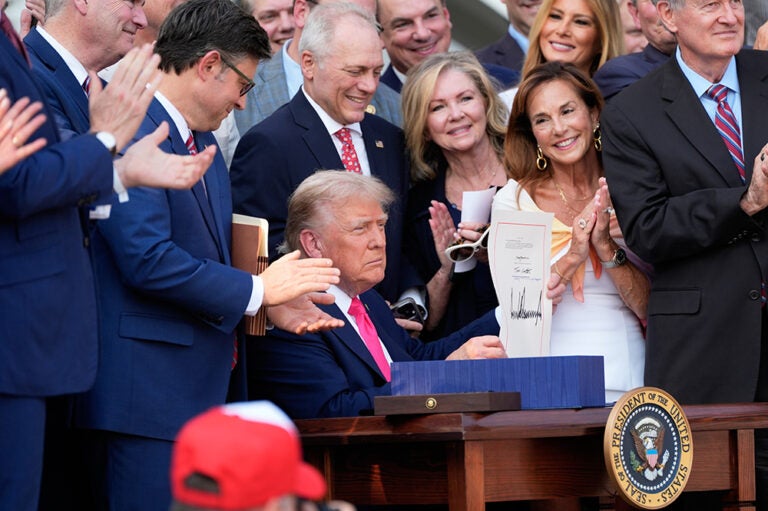Medicaid is a health insurance program targeted to lower-income recipients that is financed jointly by the federal government and the states. This budget explainer describes what Medicaid is, how it is financed, and who benefits from it.
In 2022, the latest year for which health expenditure data are available, Medicaid:
- Provided health insurance for about 91 million Americans, or about 27 percent of the U.S. population.
- Cost the federal government $592 billion, though spending in 2022 was still elevated because of some continued pandemic relief spending.
- Represented 19 percent of all health spending in the U.S.
In addition, the program plays a significant role in the country's healthcare system:
- Nearly 60 percent of all American children are covered through Medicaid and a related program, the Children's Health Insurance Program (CHIP).
- 51 percent of Medicaid's funds were spent on seniors and people with disabilities in 2021, the most recent year for which data are available.
- Medicaid was the largest single payer of long-term services and supports (58 percent) in 2022, which includes spending for nursing homes, home health services, residential care facilities, and waivers for other home and community-based services.
How Is Medicaid Financed?
Medicaid is financed jointly by the federal government and the states. In 2022, the federal government covered 71 percent of the program’s cost, spending $592 billion. The program, on average, represents 26 percent of each state’s spending and is the single largest component of expenditures across all states. Medicaid is administered by the states (but is subject to federal oversight), and as a result, there are effectively 56 different Medicaid programs (including Washington, D.C., and U.S. territories).
The federal government matches state spending on the program using various formulas. The formula that governs a majority of government funding is called federal medical assistance percentage (FMAP) and takes into account differences in per capita income among the states. The FMAP for fiscal year 2025 ranges from a minimum of 50 percent in wealthier states such as California to 77 percent in poorer states such as Mississippi.
In addition to funds governed by the FMAP, the federal government provides enhanced matching rates for select services, providers, or groups of people. For example, the Affordable Care Act (ACA) expanded the Medicaid program to cover individuals with incomes up to 133 percent of the federal poverty level, with the federal government covering nearly all the cost of coverage for the expanded population. However, states are allowed to forego the expansion of the program; as of December 2023, 10 states have chosen not to adopt the expansion. Besides receiving matching funds from the federal government, hospitals categorized as Disproportionate Share Hospitals, which serve a large number of low-income patients, are eligible for additional financing.
Finally, unlike for the states and Washington, D.C., federal funding for Medicaid in the territories is subject to a cap and a fixed matching rate. Consequently, a territory no longer receives federal support for its Medicaid program once it exhausts its federal funding for a given fiscal year.
Who Receives Medicaid?
Medicaid provides health insurance for vulnerable populations. Nearly 60 percent of the nation’s 73 million children received their health insurance through Medicaid or CHIP, which extends Medicaid benefits to children of low-income families who make too much money to qualify for the traditional Medicaid program. Just over 40 percent of pregnant women and births were covered by Medicaid in 2022. Persons with disabilities and seniors comprise 23 percent of the program’s enrollees. While Medicare is the primary health insurance program for most people over the age of 65, certain people are eligible for both Medicare and Medicaid. Those dual-eligible beneficiaries are simultaneously eligible for both programs and tend to experience high rates of chronic illness. For example, 27 percent of dually eligible individuals have six or more chronic conditions compared to 15 percent of beneficiaries with Medicare only.
Even though children make up 34 percent of Medicaid beneficiaries, they account for 14 percent of the program’s spending. Conversely, seniors and people with disabilities make up less than one-quarter of beneficiaries but account for about half of Medicaid spending. Higher spending for those groups arise from the characteristics and health status of those beneficiaries and the scope of benefits covered. For example, Medicaid accounts for roughly 60 percent of U.S. spending on long-term services and supports (LTSS), which encompass the range of services that assist with activities of daily living and is typically provided to people with disabilities, chronic illnesses, and aging individuals. Because people using LTSS have high medical needs, and many younger people with disabilities do not qualify for Medicare, users of LTSS account for 34 percent of total Medicaid expenditures.
What Services Does Medicaid Cover?
Federal rules require state Medicaid programs to cover mandatory services such as hospital care and physician care, but states may also elect to cover optional services such as physical therapy and dental care. Medicaid services are designed to take into account the needs of its population of beneficiaries. For example, children receive comprehensive screening services that are particularly important for children with special health care needs, while long-term care services are an important benefit for the seniors and people with disabilities.
Medicaid is the third largest mandatory program in the federal budget, accounting for 9 percent of federal spending in 2022, and is the single largest component of total state expenditures. As such an important component of government spending and one of the largest payers of healthcare coverage, Medicaid reform has the unique opportunity to be a driver of change and innovation in healthcare.
Further Reading
Quiz: How Much Do You Know About Healthcare in the United States?
The United States has one of the largest and most complex healthcare systems in the world. Take our healthcare quiz to see how much you know about the cost and quality of the U.S. healthcare system.
How Did the One Big Beautiful Bill Act Affect Federal Spending?
Overall, the OBBBA adds significantly to the nation’s debt, but the act contains net spending cuts that lessen that impact.
How Did the One Big Beautiful Bill Act Change Healthcare Policy?
The OBBBA adds significantly to the nation’s debt, but its healthcare provisions lessen that impact by $1.0 trillion.


